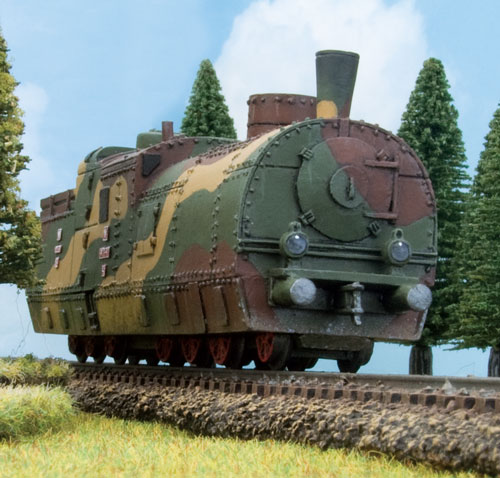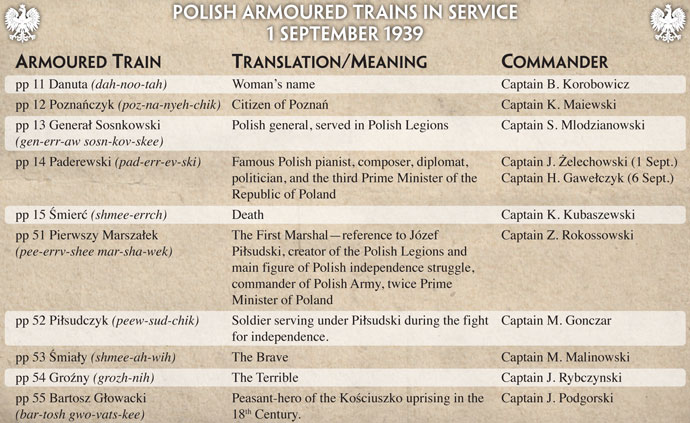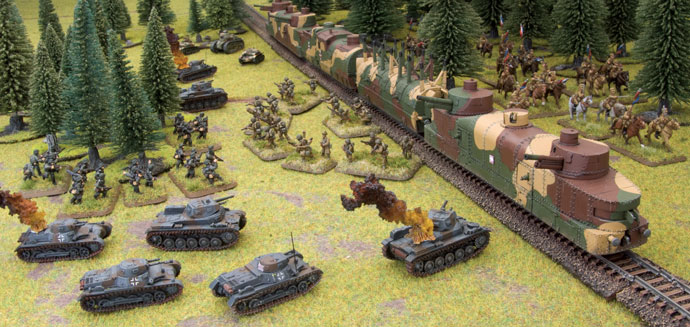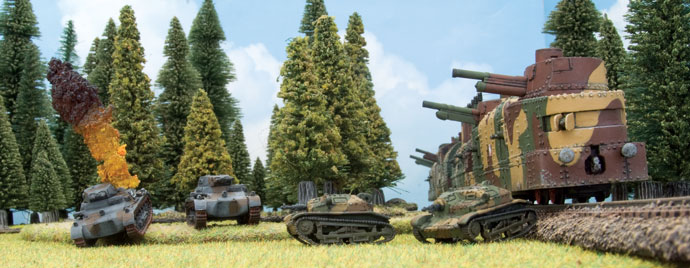|
|
 |
|
|
The Brave at Mokra and Polish Armoured Trains in World War II
 |
The Brave at Mokra and Polish Armoured Trains in World War II
by Maciek Kapałczyński
The history of Polish armoured trains starts shortly after Poland regained its independence in 1918. They were one of the most important weapons in the war against Bolsheviks in 1919 and 1920. They played an important part in other conflicts that shaped the borders of Poland. It is impossible to give the exact number of armoured trains used in the period from 1918 to 1921. There were several dozen of them, some improvised and some set up with anything that was at hand. When military operations ceased in 1921, only the twelve most combat effective trains were left in service.
Learn more about the Polish Armoured Train here...
|
In September 1939, at the start of the Second World War, the Polish Army still had ten armoured trains (Pociągów
Pancernych or pp) in two armoured train battalions (Dywizjon Pociągów Pancernych or dpp): 1. dpp based in Legionowo, and 2. dpp based in Niepołomice.
The trains were identified by their original names and by numbers. 1. dpp included trains 11 to 15 and 2. dpp trains 51 to 55. The Land Coastal Defence also had three improvised armoured trains at its disposal and in mid-September Warsaw Defence Command formed two more improvised trains.
The structure of an armoured train was specified by regulations. Leading the way, but within sight of the train, were two TK3 or TKS tankettes and an FT-17 tank mounted on individual self-propelled railcars. The main part of the train started with an empty platform car with a lookout and brake installation so the train could be stopped in case of danger. The platform car was followed by an artillery car, usually armed with one 75mm gun and one 100mm howitzer. Behind it was the assault car with a long-range radio, armed with machine guns and carrying an assault platoon of infantry. Next was the locomotive with an armoured tender carrying coal, with the commander’s station on top. This was followed by another artillery car, a platform car, and more tankettes and a tank on their rail cars.The train could operate equally well travelling in reverse.
Read the Blitzkrieg Design Notes here...
|
 |
The general make up was always the same and varied only in detail, such as the type of artillery car. Each armoured train was followed by a supply train carrying ammunition, coal, and other supplies such as track for repairing damaged rail lines. It also included accommodation cars for officers and enlisted men. Armoured trains were usually attached to other units and were tasked with patrolling, providing artillery support and covering withdrawals.
The armoured trains saw action from the very first day of the war. On 1 September, two FT-17 tanks from train No. 13, Generał Sosnkowski, took part in the defence of Vistula bridge in Tczew. Meanwhile, its train was sent south and reached Ciechanów where fighting was already under way. On the same day armoured train No. 12, Poznańczyk, was operating in support of 56th Infantry Regiment and its fire helped to stop German advance near Cieszków.
The artillery of the armoured trains provided both direct and indirect fire support. Armoured train No. 53, Śmiały, supported the defence of Mokra by the Wołyńska Cavalry Brigade against the German 4th Panzer Division, destroying a number of German tanks with direct fire over open sights. On the other hand armoured train No. 11, Danuta, stopped the advance of German 24th Infantry Division with artillery fire. German counterbattery fire had difficulty in ranging on the constantly moving train.
Learn how to paint the Polish Armoured Train here...
|
 |
Even though it might seem that armoured trains present a perfect target for aircraft, they managed to survive attacks by the German Luftwaffe (Air Force), and armoured train No. 13 even shot down a plane! In fact, no train received a direct bomb hit during the campaign. The only damage from air attacks were the above mentioned No. 13, which was derailed due to a bomb explosion near the tracks, and armoured train No. 51, Pierwszy Marszałek, damaged by an air attack.
The Polish were not the only forces that used armoured trains in September 1939, German trains also took part in
the invasion and on one occasion two armoured trains met in combat. During the siege of Modlin, on 19 September,
armoured train No. 15, Śmierć, fought an artillery duel with German armoured train No. 7, a small train equipped with just two 7.5cm guns and two 2cm anti-aircraft guns.
Armoured trains also performed many unusual operations, such as that by armoured train No. 11 on 11 September.
The train was sent to Sochaczew to counter expected German armoured attack. However, it was stopped on the way by damaged track. The crew spent two days repairing the rail line and even rebuilt a large part of an embankment, before proceeding. Another example is armoured train No. 51 that was operating in southern Poland supporting the 1st Mountain Brigade and the 10th Motorised Cavalry Brigade. On 10 September the crew of the train helped to evacuate wounded from Lublin.
See the Polish Armoured Train in action here...
|
 |
It was not only the Germans who faced Polish armoured trains. After the Soviet invasion on 17 September, armoured train No. 51 was sent to patrol Sarny-Rokitno area where it encountered a Soviet motorised column and destroyed a number of armoured cars and trucks. The train patrolled the area and supported Polish units until it was damaged by Soviet planes on 22 September.
The armoured trains proved difficult to destroy. In the end, six out of ten trains were destroyed by their own crew because they were surrounded or had no ammunition. Two were damaged and withdrawn from fighting, one derailed, and one captured by the Red Army in Lvov after the fighting ceased.
Throughout the campaign the armoured trains provided the Polish Army with what it lacked most—mobility and firepower in an well-armoured package. Despite their limitation, the armoured trains fought well and were sometimes able to influence the outcome of individual clashes, such as the battle at Mokra.
~ Maciek.
|
 |
Want To Know More About Blitzkrieg?
Over the past few months we have added a massive range of articles
about Blitzkrieg to the website, to make it easier for people to find a
specific article we have put together this handy place.
Find out more about Blitzkrieg and Early-war here...
|
Last Updated On Friday, April 15, 2011 by Blake at Battlefront
|
|
|